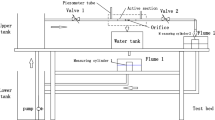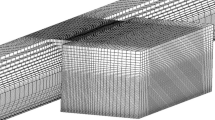Abstract
The siphon-shaped overflow tower is a new type of pressure-suppressing structure used in long water conveyance systems, and it plays a crucial role in guaranteeing the system’s stability and safety during hydraulic transient processes. The flow in the tower is characteristic of weir flow in a closed duct, and is thus a complex air-water two-phase flow. Intensive studies of the flow patterns, the pressure pulsations, and the discharge capacity are necessary for better understanding of the flow processes and for the purpose of design. In this paper, we simulate the flow in a siphon-shaped overflow tower under both steady and unsteady flow conditions. Through a steady-flow field simulation, the relationship between the overflow discharge and the pressure in the connected pipeline is analyzed and an empirical formula for evaluating the discharge capacity is provided. Through a transient-flow field simulation, the negative-pressure distributions on the weir crest, the pressure pulsations on the crest and in the falling pond, and the transformation of the air-water two-phase flow in the downstream outlet pipe are analyzed. Moreover, the major influencing factors of the flow patterns, especially, the sectional area of the air vents, are clarified. It is indicated that the siphon-shaped overflow tower can regulate the pressure surge during hydraulic transients and guarantee the safety and stability of the pipeline system, if the shape and the vents are properly designed.
Similar content being viewed by others
References
HALKIJEVIC I., VUKOVIC Z. and VOUK D. Frequency pressure regulation in water supply systems[J]. Water Science and Technology-Water Supply, 2013, 13(4): 896–905.
WAN W., HUANG W. and LI C. Sensitivity analysis for the resistance on the performance of a pressure vessel for water hammer protection[J]. Journal of Pressure Vessel Technology, 2014, 136(1): 011303.
HELENA R., SILJA T. and DIDIA C. Water supply system performance for different pipe materials Part ii: Sensitivity analysis to pressure variation[J]. Water Resources Management, 2009, 23(2): 367–393.
LIU Zhi-yong. Comparison and research on waterhammer protective measures in long pipeline systems[D]. Master Thesis, Wuhan, China: Wuhan University, 2001(in Chinese).
JUNG B. S., KARNEY B. W. Optimum selection of hydraulic devices for water hammer control in the pipeline systems using genetic algorithm[C]. 4th ASME/JSME Joint Fluids Engineering Conference. Honolulu, Hawaii, USA, 2003.
DUAN H. F., TUNG Y. K. and GHIDAOUI M. S. Probabilistic analysis of transient design for water supply systems[J]. Journal of Water Resources Planning and Management, 2010, 136(6): 678–687.
ALI N. A., ABOZEID G. and DARWEESH M. S. Analysis of different protection methods against water hammer on water supply network (case study-Assiut city network)[J]. Journal of Engineering Sciences, 2013, 41(6): 2021–2035.
WANG L., WANG F. J. and ZOU Z. C. et al. Effects of air vessel on water hammer in high-head pumping station[C]. 6th International Conference on Pumps and Fans with Compressors and Wind Turbines (ICPF). Beijing, China, 2013.
LAPTOS K. T., BROWN M. T. and SHAMBAUGH J. R. Pressure transient control strategies for water pipeline systems[C]. Proceedings of the ASCE International Conference on Pipeline Engineering and Construction (New Pipeline Technologies, Security, and Safety). Baltimore, Maryland, USA, 2003.
PAN Qin, LIU Ya-kun and NI Han-gen et al. Hydraulic experiments on double-pipe overflow tower[J]. Journal of Hydraulic Engineering, 2007, (Suppl.): 352–355(in Chinese).
ZHANG Xiao-xi, CHENG Yong-guang. Simulation of hydraulic transients in hydropower systems using the 1-D-3-D coupling approach[J]. Journal of Hydrodynamics, 2012, 24(4): 595–604.
ZHANG Xiao-xi, CHENG Yong-guang and YANG Jiandong et al. Simulation of the load rejection transient process of a francis turbine by using a 1-D-3-D coupling approach[J]. Journal of Hydrodynamics, 2014, 26(5): 715–724.
KUNDU P. K., COHEN I. M. and DOWLING D. R. Fluid mechanics[M]. 5th Edition, Waltham, MA, USA: Academic Press, 2012.
SCHMITT F. G. About Boussinesq’s turbulent viscosity hypothesis: Historical remarks and a direct evaluation of its validity[J]. Comptes Rendus Mecanique, 2007, 335(9–10): 617–627.
POPE S. B. The determination of turbulence-model statistics from the velocity-acceleration correlation[J]. Journal of Fluid Mechanics, 2014, 757: 1–9.
KIM W. J., KIM D. H. and VAN S. H. Computational study on turbulent flows around modern tanker hull forms[J]. International Journal for Numerical Methods in Fluids, 2002, 38(4): 377–406.
GAO D., MORLEY N. B. and DHIR V. Numerical simulation of wavy falling film flow using VOF method[J]. Journal of Computational Physics, 2003, 192(2): 624642.
NAZIF H. R., TABRIZI H. B. Comparison of standard turbulent wall function with a non-equilibrium wall model[J]. International Journal of Fluid Mechanics Research, 2011, 38(6): 499–508.
Author information
Authors and Affiliations
Corresponding author
Additional information
Project supported by the National Natural Science Foundation of China (Grant Nos. 51039005, 50909076 and 51579187).
Biography: Kang YU (1992-), Male, Ph. D.
Rights and permissions
About this article
Cite this article
Yu, K., Cheng, Yg. & Zhang, Xx. Hydraulic characteristics of a siphon-shaped overflow tower in a long water conveyance system: CFD simulation and analysis. J Hydrodyn 28, 564–575 (2016). https://doi.org/10.1016/S1001-6058(16)60660-1
Received:
Revised:
Published:
Issue Date:
DOI: https://doi.org/10.1016/S1001-6058(16)60660-1




